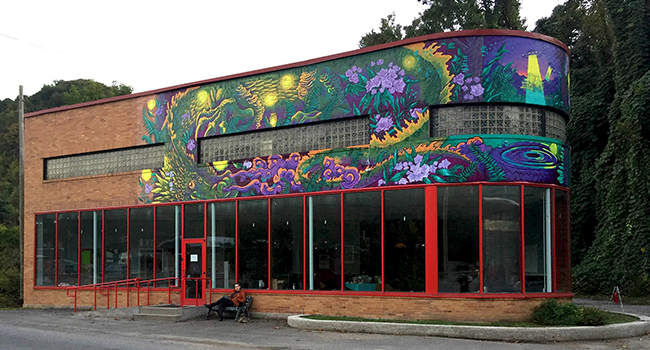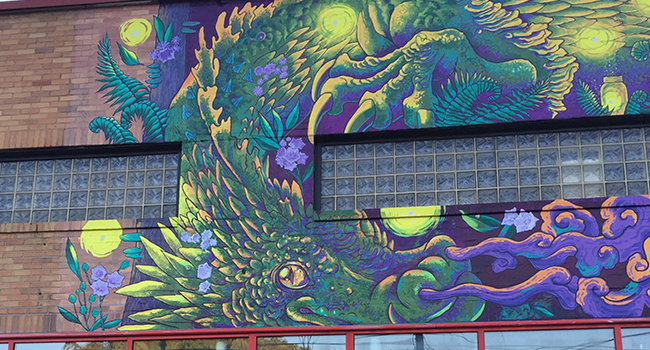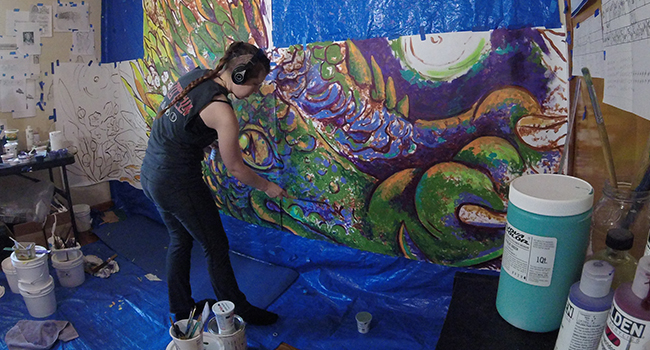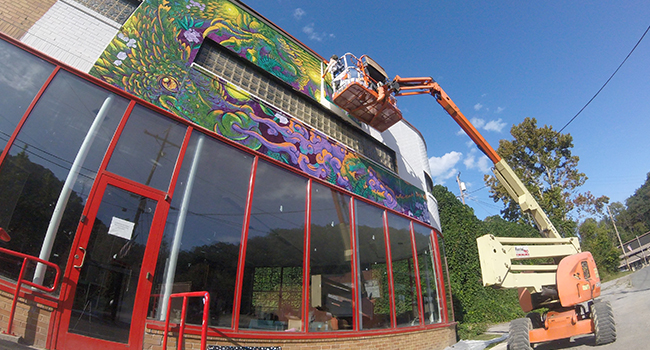By Steven Krolak
(NEW ALBANY, Ind.)—The Cumberland dragon has been spotted in the Eastern Kentucky town of Whitesburg!
Over fifty feet long, with purple scales and syrupy yellow eyes, it has been seen moving among the wild mushrooms and mountain laurel, while in the woods beyond, a flying saucer has been seen abducting a pickup truck with a tractor beam, as Sasquatch dances with fireflies amid the ferns and fungi–aaactually, full disclosure: none of this is really happening.
The dragon, Sasquatch, UFO and all the rest are figures in a stunning mural adorning the curving Art Deco facade of the Boone Building, a former auto showroom at the entrance to town that now functions as a youth drop-in center and safespace for LGBTQ+ locals.
The mural is the work of Amie Villiger Harris ’13. It’s a bold blast of creativity that combines the artist’s love of nature with her flair for fantasy and relish for technical challenges.

It all began in 2017, when Harris and her husband Sterling relocated to Eastern Kentucky, where he had been posted through the Teach for America program. To pursue her own opportunities, Harris sought out the local art scene.
She soon discovered a diverse, deeply rooted and energized community of creatives, many of whom play a role in the organization called Appalshop.
Based in Whitesburg, Appalshop has provided arts education and community development for youth in its area since 1969.
Today’s Appalshop initiatives include a radio station, theater, art gallery, record label, filmmaking institute, community development and reproductive justice programs, and much more.
“They are a very important institution that lifts up local and regional voices,” Harris said. “They also do a lot of work to dispel Appalachian stereotypes.”
A lot of that work happens in the Boone Building, which also houses the organization’s Appalachian Media Institute.
When Appalshop requested proposals for a mural for the Boone Building, Harris submitted an entry.
Having studied painting, theater design and graphic design at IU Southeast and a previous institution, Harris had become accomplished in murals, which utilize skills from all three disciplines. She had also been a member of the creative team behind Louisville’s Jack O’Lantern Spectacular since 2014, transforming pumpkins into virtuoso expressions, often inspired by masterpieces of the past, blending human creativity with an appreciation for the environment..
During conversations with the Appalshop team, a theme emerged.
“They wanted something cryptid-related,” Harris said. “And it needed to be colorful, inviting, quirky, and in some way include a nod to the history of the building.”
Cryptids are creatures that may or may not exist. It’s a big field. But in fact, there happened to be a local cryptid of some renown: the Cumberland dragon.
Known to native people but sighted by American soldiers only once, in 1794, slipping in and out of thickets of mountain laurel, spewing poisonous breath that could kill on contact, the dragon has haunted the region and its lore.

Harris dove into the history, becoming more intrigued the deeper she went. She discovered that central and southern Appalachia has the highest biodiversity of salamanders in the world, strengthening the emblematic nature of the dragon.
“I really like that the Cumberland dragon is a little more obscure as cryptids go, and it’s more local,” Harris said. “I also really like how, if you read the story about the sighting, you see all these hidden, wondrous bits of nature and wildlife, not yet touched by humans, nestled away in the remnants of the wild parts of the world.”
For Harris, nature is a creative touchstone, and the work inevitably became a love letter to the region, with its hidden hollows, stands of laurel, summer nights ablaze with lightning bugs.
“I wanted my dragon to be very much part of the landscape it inhabited, hidden and part of the mountains,” Harris said. “That’s why its scales and spine look leafy, and moss and mushrooms grow from its back.”
In dozens of sketches, she blended these local elements with inspirations from her dog’s face and characters from “The Dragon Prince” and “The Legend of Zelda” to achieve her own interpretation.
Beyond the concept itself, the mural project presented several technical challenges, including the height of the Boone Building’s exterior walls and the weather.
To overcome these hurdles, Harris chose the polytab method, a nontraditional approach that she had never used before. Instead of painting directly onto the wall, the artist breaks the design down into a grid system, paints the mural in these sections onto non-woven fabric “polytab” panels, then permanently installs them onto the wall with the aid of a lift. The effect and the life-span, according to Harris, are indistinguishable from murals painted in the traditional way.
“If you look closely at my dragon mural, you can see the texture of the brick and mortar,” Harris said. “It appears as though it’s painted right on the wall.”
The daring foray into new territory brought together Harris’ adventure-friendly life path, her creative openness and her love of learning. She had only recently become aware of the polytab technique in 2019 at the Great Mountain Mural Mega Fest in Harlan, Kentucky, where Kentucky muralists work alongside expert practitioners from groups like Goodspace Murals in Minneapolis, Minnesota, as well as stars of the discipline such as Lacy Hale and the Italian street artist Hitnes, learning as they go.

“This process greatly appealed to me as a trained studio artist,” Harris said. “It allowed me to spend more time and apply more detail on each part of the mural, with the added bonus of being able to work at night and not be at the mercy of the elements.”
The dragon is not Villiger’s first mural. In this medium, she enjoys the unique give-and-take with the public space, and the people in it. Collaboration with stakeholders is almost always part of the process, and this adds a layer of depth and resonance. For example, last year she produced a mural for a local elementary school, based on what the children had said they wanted to be when they grow up.
“When it comes to murals, sometimes they include some community input during the design process, which is really cool because the final piece will have that much more of a connection and meaning with that community,” Villiger said. “I enjoy being able to use my artistic and creative skills to assist and collaborate with a community in making a thing that represents and inspires them.”
That sensitivity is reflected in all the “rubbernecking” that Marley Green, Appalshop’s community development worker, has noticed along the street.
“The reactions to the mural have been really positive and excited,” Green said. “It’s an awesome addition to our downtown streetscape, with vibrant colors, familiar plants and other images, and a kind of mysteriousness that only resolves when you take a few minutes to look at it up close.”
Green valued working with Villiger, who successfully blended inputs from Appalshop visioning groups with her own imagination to create, as he put it, “an image that is uniquely from her mind and hand, but reflects the stories and ideas that we heard from our community.”
Alexandra Werner-Winslow, Appalshop’s communications director, believes that that the mural successfully heightens the visibility of the organization.
“We’re so thrilled to be able to support regional artists like Amie, and to have her beautiful work enliven our footprint in Whitesburg, Kentucky,” Werner-Winslow said. “Everyone from young people who take part in programming in our Boone building to community members who’ve never stepped foot in it have commented on the mural’s colors, its placement, and the design itself.”
Harris’ success is no surprise to Debra Clem, professor of fine arts and head of the painting area. She was Harris’ instructor and mentor during the artist’s undergraduate years.
“Amie was one of the best students I have had,” Clem said. “She loved learning–so very curious about the things around her–and she was also tenacious, with the stubborn stick-to-it-ness that is necessary to succeed as an artist.”
Clem recalls Harris as initially tentative, growing in confidence as she overcame challenges of proportion, composition, color and space, improving through listening to comments on her work, paying attention to what she was doing, being creatively fearless, and persisting.

“At one point, she started an oil painting of a series of creeks–water flowing over rocks, conveying a sense of transparency, using color and light in a very effective way,” Clem said. “I think the delight of working on that series of paintings hooked her to the painting process, and she hasn’t looked back.”
Indeed, Harris’ portfolio, selections of which can be seen on her website, reveals a powerful individual voice, and a courageous eye, be it in painting, drawing, murals or the unique theatrics of pumpkin carving.
“She’s clearly matured as an artist, and she’s working with amazing confidence and ambition,” Clem said. “She’s doing large-scale, physical work, which adds to the challenge. But all her hard-earned skills, and her curiosity for problem-solving, built on what she has learned in the past, is kicking in.”
For her part, Harris credits her undergraduate education with helping her nurture a professional mentality as well as build technique.
“All of my classes in the fine arts, including painting, graphic design, art history, printmaking, and drawing, provided me with so many important skills and knowledge that I still use today,” Harris said. “Artistic techniques, color theory, composition, dealing with clients–all these things, and especially being put through the ringer in BFA critiques, helped me get to where I am now.”
The Cumberland dragon is both a culmination and a new beginning, as Harris continues to pursue her creative vision, as expressed in her artist statement: an exploration of the intersections of reality and the mystical and fantastical, the repetition of patterns and archetypal truths through time and myth, humanity’s (especially women’s) relationship to nature.
“It’s exciting to think about what we don’t know yet, what’s unexplored, with lots of species still being discovered, even today when we often think nothing’s new, the map’s explored, and the wilderness sadly disappearing,” Harris said. “Dragons may be mythical beings, but the idea of the wild and unknown, the mythical, the untamable, the primal, and the magic of nature that does exist in our world and should be respected, that very much resonates with me.”
Homepage photo: Amie Villiger Harris ’13 installs the Cumberland dragon mural in Whitesburg, Kentucky. Photo courtesy of Amie Villiger Harris.


